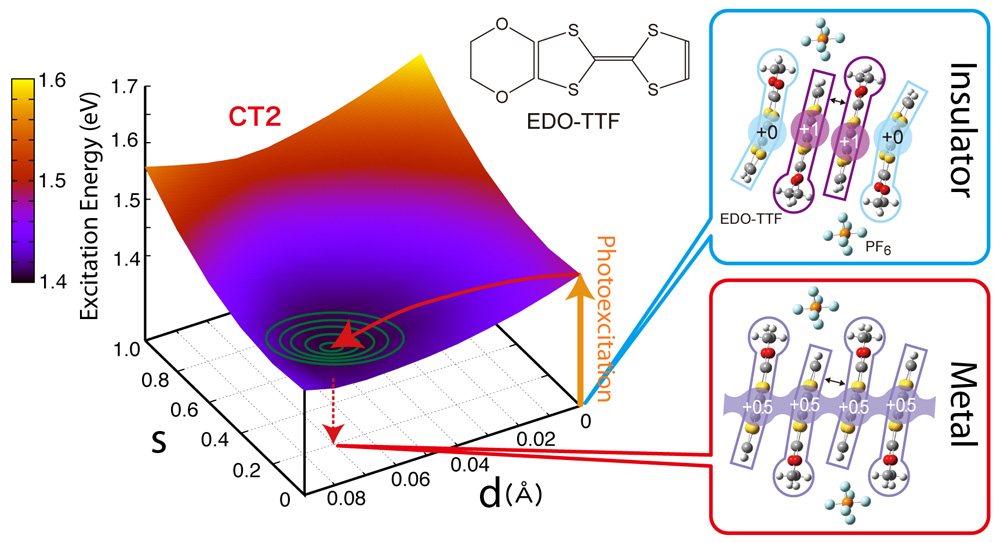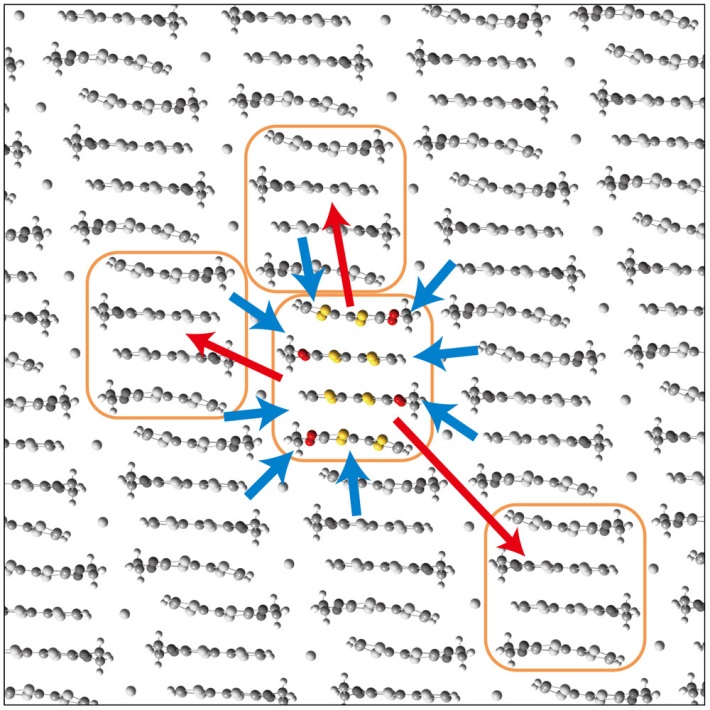Press Release
Revealing the mechanism of photoinduced phase transition in a molecular solid, (EDO-TTF)2PF6
– Supercomputer makes it possible to trace how the material changes after photoexcitation –
March 26, 2013
High Energy Accelerator Research Organization, KEK
A quasi-one-dimensional molecular solid, (EDO-TTF)2PF6, is known to exhibit a macroscopic phase change after photoexcitation. This phase change is categorized as a transition from an insulating state with a type of charge ordering to a metallic state with the charge order being melted, as illustrated on the right-hand side of Fig. 1. Although this phenomenon has already been confirmed experimentally to occur within the time scale of 100 ps, the mechanism or driving force has not been discussed so far because of the difficulty of treating this type of problem theoretically.
A joint group of Dr. Kaoru Iwano at the High Energy Accelerator Research Organization (KEK) and Dr. Yukihiro Shimoi at the National Institute for Advanced Industrial Science and Technology (AIST) has proposed a new theoretical framework, which is based on the self-consistent environment. The framework is illustrated in Fig. 2. Here, only the central tetramer of EDO-TTF molecules is calculated quantum mechanically, while the other tetramers are treated as a collection of point charges that affect the central one via Coulombic interaction and/or van der Waals interaction. The point charges in the environment are determined iteratively so as to be self-consistent with the valencies of their corresponding atoms in the quantum region. Using this framework, we succeeded in preparing a stable molecular cluster that reproduces the following key aspects in the insulating state, which are indispensable for studying photoinduced effects:
(1) Molecular valencies,
(2) Absorption spectrum, and
(3) Vibrational spectra.
Figure 1 shows the main result obtained in this research, namely, the adiabatic potential-energy surface for the so-called CT2 excitation, with respect to two coordinates, d and s (see Fig. 3 for the definition of the coordinates). The d coordinate increases the mutual distance of the two inner EDO-TTF molecules in the tetramer, while the s coordinate changes the molecular shapes from flat to bent and vice versa. The obtained potential-energy surface clearly indicates a pathway from the insulating state to the metallic state. We conclude that this pathway is the very beginning of this photoinduced phase transition.
We believe that the present framework is applicable to other systems including not only other molecular solids but also oxides and metal complexes. This study is expected to open up a new direction of research involving close collaboration between both time-resolved experiments and theoretical approaches, and thus contribute to fruitful research utilizing the planned next synchrotron source, the Energy Recovery Linac (ERL) at KEK.

Fig. 1. Adiabatic potential-energy surface for the CT2 excitation. The orange arrow and the red arrow show the photoexcitation and the possible relaxation after it, respectively. The two equilibrium states, the insulating state and the metallic state, are illustrated on the right-hand side. Regarding the two coordinates, i.e., the s and d coordinates, see Fig. 3.

Fig. 2. Concept of the self-consistent environment. The blue arrow shows the effects from the environment to the central system cluster via Coulombic and van der Waals interactions, while the red arrow means the copying of the system valencies to the charges in the environment.

Fig. 3. Illustration of the d and s coordinates used in Fig. 1.
Media Contact
Public Relations Office, High Energy Accelerator Research Organization (KEK), Japan
Tel: +81-29-879-6047
Fax: +81-29-879-6049
E-mail: press@kek.jp